Business Outsourcing Report: Examining Advantages and Disadvantages
VerifiedAdded on 2020/03/13
|11
|2900
|47
Report
AI Summary
This report provides a comprehensive overview of business outsourcing, examining its advantages and disadvantages in the context of globalization and evolving business dynamics. The introduction highlights the shift towards outsourcing as companies focus on core competencies and seek cost savings. The report defines business outsourcing, differentiating between on-site and off-site models, and explores the motivations behind outsourcing, including cost reduction and market expansion. A literature review synthesizes existing research, outlining the seven key steps in the outsourcing life cycle and highlighting the benefits such as enhanced focus on core competencies, increased revenue, access to world-class capabilities, and risk minimization. The report also delves into the disadvantages of outsourcing, including customer conflict, security issues, ethical concerns, job losses, and communication challenges, along with quality control issues. The conclusion summarizes the key findings, emphasizing the strategic considerations and potential risks associated with business outsourcing. The report draws on various research papers and studies to support its arguments.
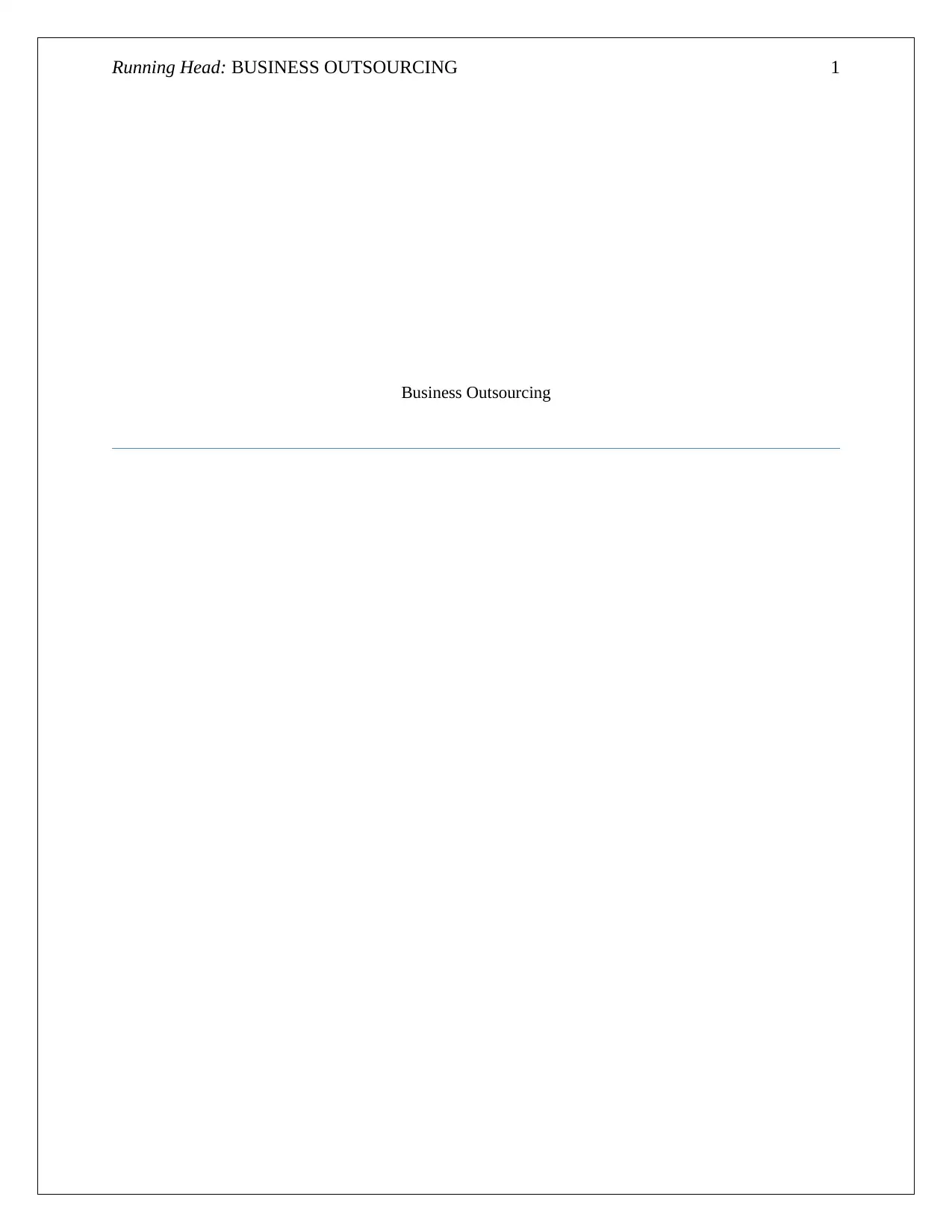
Running Head: BUSINESS OUTSOURCING 1
Business Outsourcing
Business Outsourcing
Paraphrase This Document
Need a fresh take? Get an instant paraphrase of this document with our AI Paraphraser
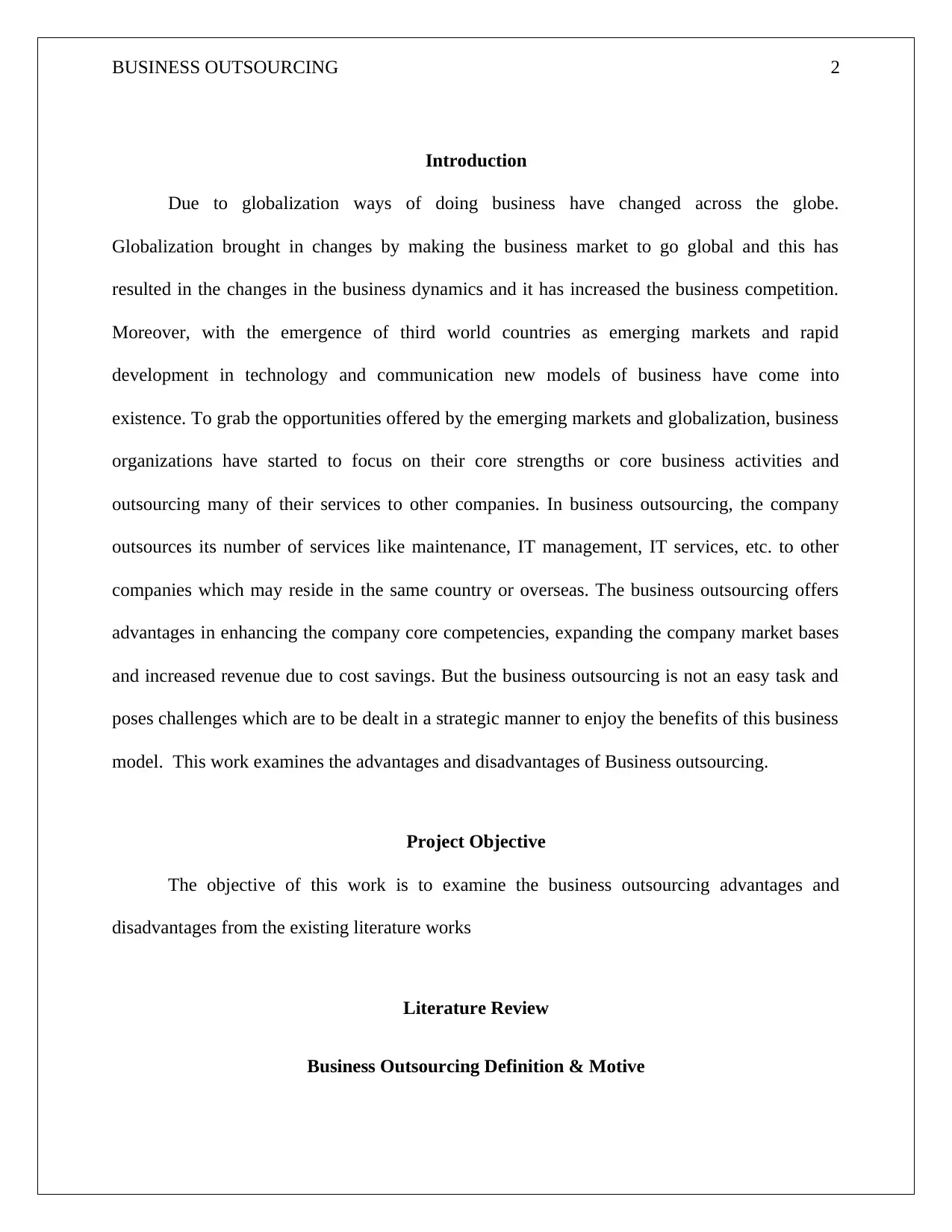
BUSINESS OUTSOURCING 2
Introduction
Due to globalization ways of doing business have changed across the globe.
Globalization brought in changes by making the business market to go global and this has
resulted in the changes in the business dynamics and it has increased the business competition.
Moreover, with the emergence of third world countries as emerging markets and rapid
development in technology and communication new models of business have come into
existence. To grab the opportunities offered by the emerging markets and globalization, business
organizations have started to focus on their core strengths or core business activities and
outsourcing many of their services to other companies. In business outsourcing, the company
outsources its number of services like maintenance, IT management, IT services, etc. to other
companies which may reside in the same country or overseas. The business outsourcing offers
advantages in enhancing the company core competencies, expanding the company market bases
and increased revenue due to cost savings. But the business outsourcing is not an easy task and
poses challenges which are to be dealt in a strategic manner to enjoy the benefits of this business
model. This work examines the advantages and disadvantages of Business outsourcing.
Project Objective
The objective of this work is to examine the business outsourcing advantages and
disadvantages from the existing literature works
Literature Review
Business Outsourcing Definition & Motive
Introduction
Due to globalization ways of doing business have changed across the globe.
Globalization brought in changes by making the business market to go global and this has
resulted in the changes in the business dynamics and it has increased the business competition.
Moreover, with the emergence of third world countries as emerging markets and rapid
development in technology and communication new models of business have come into
existence. To grab the opportunities offered by the emerging markets and globalization, business
organizations have started to focus on their core strengths or core business activities and
outsourcing many of their services to other companies. In business outsourcing, the company
outsources its number of services like maintenance, IT management, IT services, etc. to other
companies which may reside in the same country or overseas. The business outsourcing offers
advantages in enhancing the company core competencies, expanding the company market bases
and increased revenue due to cost savings. But the business outsourcing is not an easy task and
poses challenges which are to be dealt in a strategic manner to enjoy the benefits of this business
model. This work examines the advantages and disadvantages of Business outsourcing.
Project Objective
The objective of this work is to examine the business outsourcing advantages and
disadvantages from the existing literature works
Literature Review
Business Outsourcing Definition & Motive

BUSINESS OUTSOURCING 3
Business outsourcing is a business strategy where some of the operations or business
processes which can be executed in-house by the organization are subcontracted to another
organization for a given period of time. These tasks can be then performed on-site or off-site.
Literature has various references to thedefinition of business outsourcing. According to
Gantman, (2011), Business outsourcing is said to take place when a company transfers some of
its activities to an outside company and this outsourcing is said to be offshore if these tasks are
performed by the organization residing in some other country. Similarly, according to Gerbl et
al. (2015), the business outsourcing is a management strategy by a business organization where
in the organization outsources some of its non-core functions to specialized and efficient
companies which act as the service providers.
The whole company and its businessare affected by the strategic decisionof business
process outsourcing. There are many reasons for which the organization may outsource its
business activities. Themostcommon motivation for business outsourcing is cost reduction. For
others, it may be an opportunity to enhance the focus of the organization on the core business
activities (Hanafizadeh et al, 2017).
According to Hen et al. (2013), the main reason for worldwidebusiness outsourcing is
high-wage organizationscan take benefits of low market wage rates for example inoverseas
countries where the labor rates are lower than the original country labor rates.
From the study of Alaghehband et al. (2011), it is found that reducing its working costs,
and starting a worldwide presence and to become more strong and more competitive in the
market are the main reasons which drive thecompany to adapt the business strategy of
outsourcing.
Business outsourcing is a business strategy where some of the operations or business
processes which can be executed in-house by the organization are subcontracted to another
organization for a given period of time. These tasks can be then performed on-site or off-site.
Literature has various references to thedefinition of business outsourcing. According to
Gantman, (2011), Business outsourcing is said to take place when a company transfers some of
its activities to an outside company and this outsourcing is said to be offshore if these tasks are
performed by the organization residing in some other country. Similarly, according to Gerbl et
al. (2015), the business outsourcing is a management strategy by a business organization where
in the organization outsources some of its non-core functions to specialized and efficient
companies which act as the service providers.
The whole company and its businessare affected by the strategic decisionof business
process outsourcing. There are many reasons for which the organization may outsource its
business activities. Themostcommon motivation for business outsourcing is cost reduction. For
others, it may be an opportunity to enhance the focus of the organization on the core business
activities (Hanafizadeh et al, 2017).
According to Hen et al. (2013), the main reason for worldwidebusiness outsourcing is
high-wage organizationscan take benefits of low market wage rates for example inoverseas
countries where the labor rates are lower than the original country labor rates.
From the study of Alaghehband et al. (2011), it is found that reducing its working costs,
and starting a worldwide presence and to become more strong and more competitive in the
market are the main reasons which drive thecompany to adapt the business strategy of
outsourcing.
⊘ This is a preview!⊘
Do you want full access?
Subscribe today to unlock all pages.

Trusted by 1+ million students worldwide
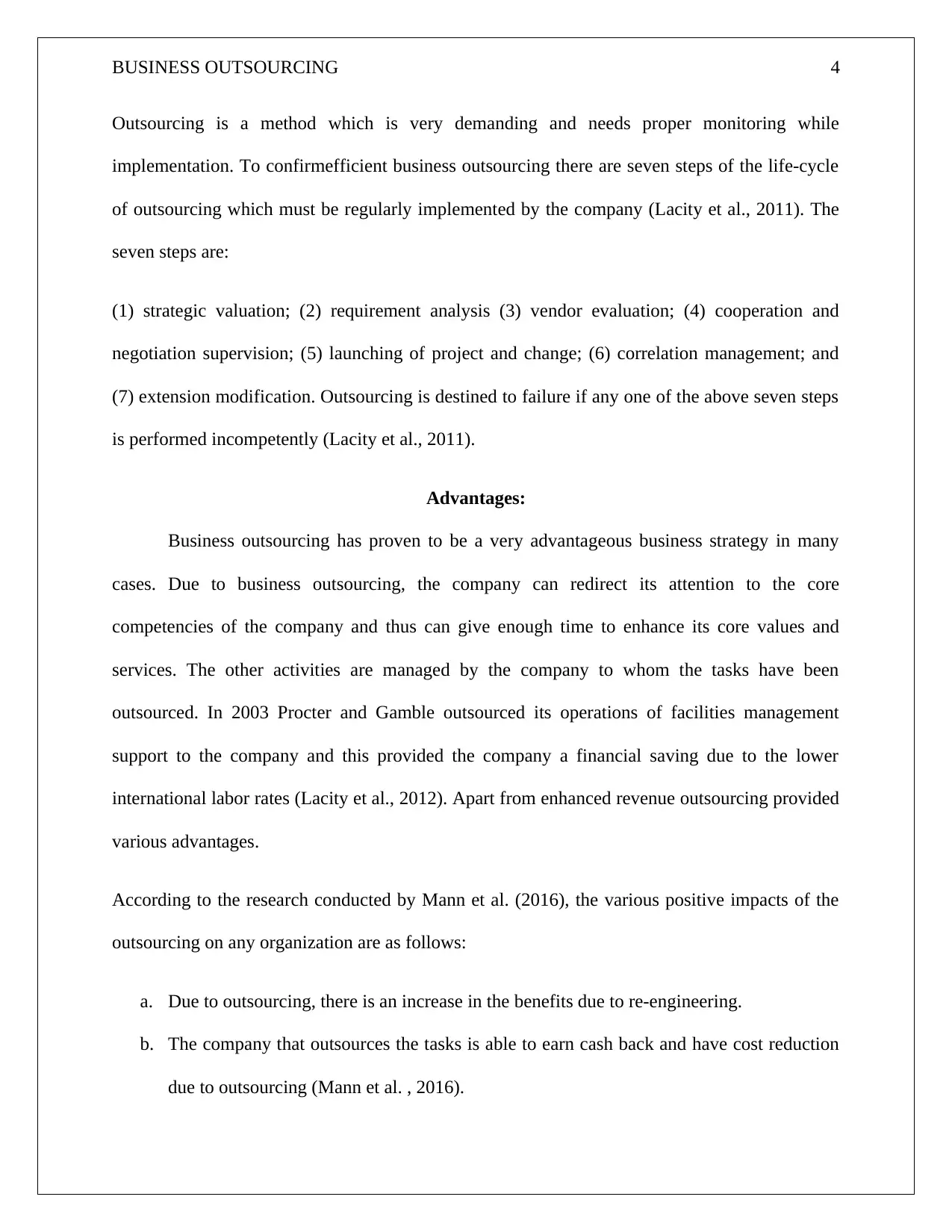
BUSINESS OUTSOURCING 4
Outsourcing is a method which is very demanding and needs proper monitoring while
implementation. To confirmefficient business outsourcing there are seven steps of the life-cycle
of outsourcing which must be regularly implemented by the company (Lacity et al., 2011). The
seven steps are:
(1) strategic valuation; (2) requirement analysis (3) vendor evaluation; (4) cooperation and
negotiation supervision; (5) launching of project and change; (6) correlation management; and
(7) extension modification. Outsourcing is destined to failure if any one of the above seven steps
is performed incompetently (Lacity et al., 2011).
Advantages:
Business outsourcing has proven to be a very advantageous business strategy in many
cases. Due to business outsourcing, the company can redirect its attention to the core
competencies of the company and thus can give enough time to enhance its core values and
services. The other activities are managed by the company to whom the tasks have been
outsourced. In 2003 Procter and Gamble outsourced its operations of facilities management
support to the company and this provided the company a financial saving due to the lower
international labor rates (Lacity et al., 2012). Apart from enhanced revenue outsourcing provided
various advantages.
According to the research conducted by Mann et al. (2016), the various positive impacts of the
outsourcing on any organization are as follows:
a. Due to outsourcing, there is an increase in the benefits due to re-engineering.
b. The company that outsources the tasks is able to earn cash back and have cost reduction
due to outsourcing (Mann et al. , 2016).
Outsourcing is a method which is very demanding and needs proper monitoring while
implementation. To confirmefficient business outsourcing there are seven steps of the life-cycle
of outsourcing which must be regularly implemented by the company (Lacity et al., 2011). The
seven steps are:
(1) strategic valuation; (2) requirement analysis (3) vendor evaluation; (4) cooperation and
negotiation supervision; (5) launching of project and change; (6) correlation management; and
(7) extension modification. Outsourcing is destined to failure if any one of the above seven steps
is performed incompetently (Lacity et al., 2011).
Advantages:
Business outsourcing has proven to be a very advantageous business strategy in many
cases. Due to business outsourcing, the company can redirect its attention to the core
competencies of the company and thus can give enough time to enhance its core values and
services. The other activities are managed by the company to whom the tasks have been
outsourced. In 2003 Procter and Gamble outsourced its operations of facilities management
support to the company and this provided the company a financial saving due to the lower
international labor rates (Lacity et al., 2012). Apart from enhanced revenue outsourcing provided
various advantages.
According to the research conducted by Mann et al. (2016), the various positive impacts of the
outsourcing on any organization are as follows:
a. Due to outsourcing, there is an increase in the benefits due to re-engineering.
b. The company that outsources the tasks is able to earn cash back and have cost reduction
due to outsourcing (Mann et al. , 2016).
Paraphrase This Document
Need a fresh take? Get an instant paraphrase of this document with our AI Paraphraser

BUSINESS OUTSOURCING 5
c. Outsourcing provides gain to world class capabilities, technology, and innovation
d. Due to outsourcing, many company core resources can be used for other purposes that
can be used to enhance the company services (Mann et al., 2016).
e. due to outsourcing it is easier to have areevaluation of the problematic functions of the
core company
f. outsourcing enhances the company focus on core activities
g. It becomes easier for the company to make capital funds be available for the company
h. the overall operational costs are reduced due to outsourcing
i. Risk minimization occurs due to outsourcing (Mann et al., 2016).
According to Lacity et al (2014), the four advantages of strategic partnership due to business
outsourcingdefined by these four advantages are as follows;(1) enhancing knowledge
management; (2) external visibility enhances; (3) internal coordination is easily provided; and (4)
intervention and accountability is maintained
Massini et al. (2012),emphasize the (1) hiring good professional skills; (2) choosing
partnerships can be done; and (3) external solutions integration as the main positive impacts of
outsourcing.
Thus the overall advantages of the business outsourcing from various literaturecan be
presented as follows:
Operating costs (control and reduction). Rather than employing specialist expensive
employees for particular tasks that may be for a small duration thus making the employee be
ideal for rest of the time, in such scenario outsourcing proves to be a beneficial option.
Outsourcing firms are cheaper because they provide similar kind of services to many companies
c. Outsourcing provides gain to world class capabilities, technology, and innovation
d. Due to outsourcing, many company core resources can be used for other purposes that
can be used to enhance the company services (Mann et al., 2016).
e. due to outsourcing it is easier to have areevaluation of the problematic functions of the
core company
f. outsourcing enhances the company focus on core activities
g. It becomes easier for the company to make capital funds be available for the company
h. the overall operational costs are reduced due to outsourcing
i. Risk minimization occurs due to outsourcing (Mann et al., 2016).
According to Lacity et al (2014), the four advantages of strategic partnership due to business
outsourcingdefined by these four advantages are as follows;(1) enhancing knowledge
management; (2) external visibility enhances; (3) internal coordination is easily provided; and (4)
intervention and accountability is maintained
Massini et al. (2012),emphasize the (1) hiring good professional skills; (2) choosing
partnerships can be done; and (3) external solutions integration as the main positive impacts of
outsourcing.
Thus the overall advantages of the business outsourcing from various literaturecan be
presented as follows:
Operating costs (control and reduction). Rather than employing specialist expensive
employees for particular tasks that may be for a small duration thus making the employee be
ideal for rest of the time, in such scenario outsourcing proves to be a beneficial option.
Outsourcing firms are cheaper because they provide similar kind of services to many companies
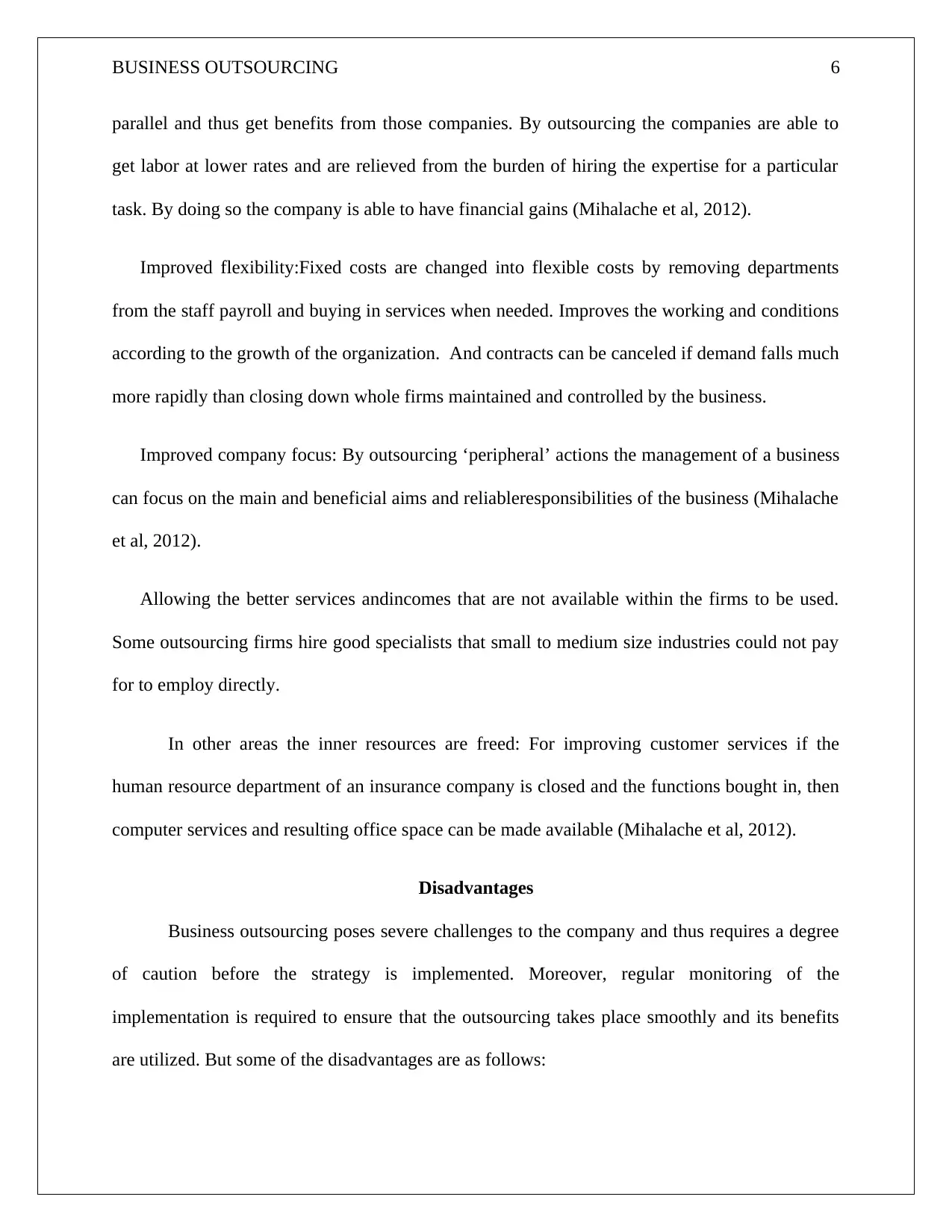
BUSINESS OUTSOURCING 6
parallel and thus get benefits from those companies. By outsourcing the companies are able to
get labor at lower rates and are relieved from the burden of hiring the expertise for a particular
task. By doing so the company is able to have financial gains (Mihalache et al, 2012).
Improved flexibility:Fixed costs are changed into flexible costs by removing departments
from the staff payroll and buying in services when needed. Improves the working and conditions
according to the growth of the organization. And contracts can be canceled if demand falls much
more rapidly than closing down whole firms maintained and controlled by the business.
Improved company focus: By outsourcing ‘peripheral’ actions the management of a business
can focus on the main and beneficial aims and reliableresponsibilities of the business (Mihalache
et al, 2012).
Allowing the better services andincomes that are not available within the firms to be used.
Some outsourcing firms hire good specialists that small to medium size industries could not pay
for to employ directly.
In other areas the inner resources are freed: For improving customer services if the
human resource department of an insurance company is closed and the functions bought in, then
computer services and resulting office space can be made available (Mihalache et al, 2012).
Disadvantages
Business outsourcing poses severe challenges to the company and thus requires a degree
of caution before the strategy is implemented. Moreover, regular monitoring of the
implementation is required to ensure that the outsourcing takes place smoothly and its benefits
are utilized. But some of the disadvantages are as follows:
parallel and thus get benefits from those companies. By outsourcing the companies are able to
get labor at lower rates and are relieved from the burden of hiring the expertise for a particular
task. By doing so the company is able to have financial gains (Mihalache et al, 2012).
Improved flexibility:Fixed costs are changed into flexible costs by removing departments
from the staff payroll and buying in services when needed. Improves the working and conditions
according to the growth of the organization. And contracts can be canceled if demand falls much
more rapidly than closing down whole firms maintained and controlled by the business.
Improved company focus: By outsourcing ‘peripheral’ actions the management of a business
can focus on the main and beneficial aims and reliableresponsibilities of the business (Mihalache
et al, 2012).
Allowing the better services andincomes that are not available within the firms to be used.
Some outsourcing firms hire good specialists that small to medium size industries could not pay
for to employ directly.
In other areas the inner resources are freed: For improving customer services if the
human resource department of an insurance company is closed and the functions bought in, then
computer services and resulting office space can be made available (Mihalache et al, 2012).
Disadvantages
Business outsourcing poses severe challenges to the company and thus requires a degree
of caution before the strategy is implemented. Moreover, regular monitoring of the
implementation is required to ensure that the outsourcing takes place smoothly and its benefits
are utilized. But some of the disadvantages are as follows:
⊘ This is a preview!⊘
Do you want full access?
Subscribe today to unlock all pages.

Trusted by 1+ million students worldwide
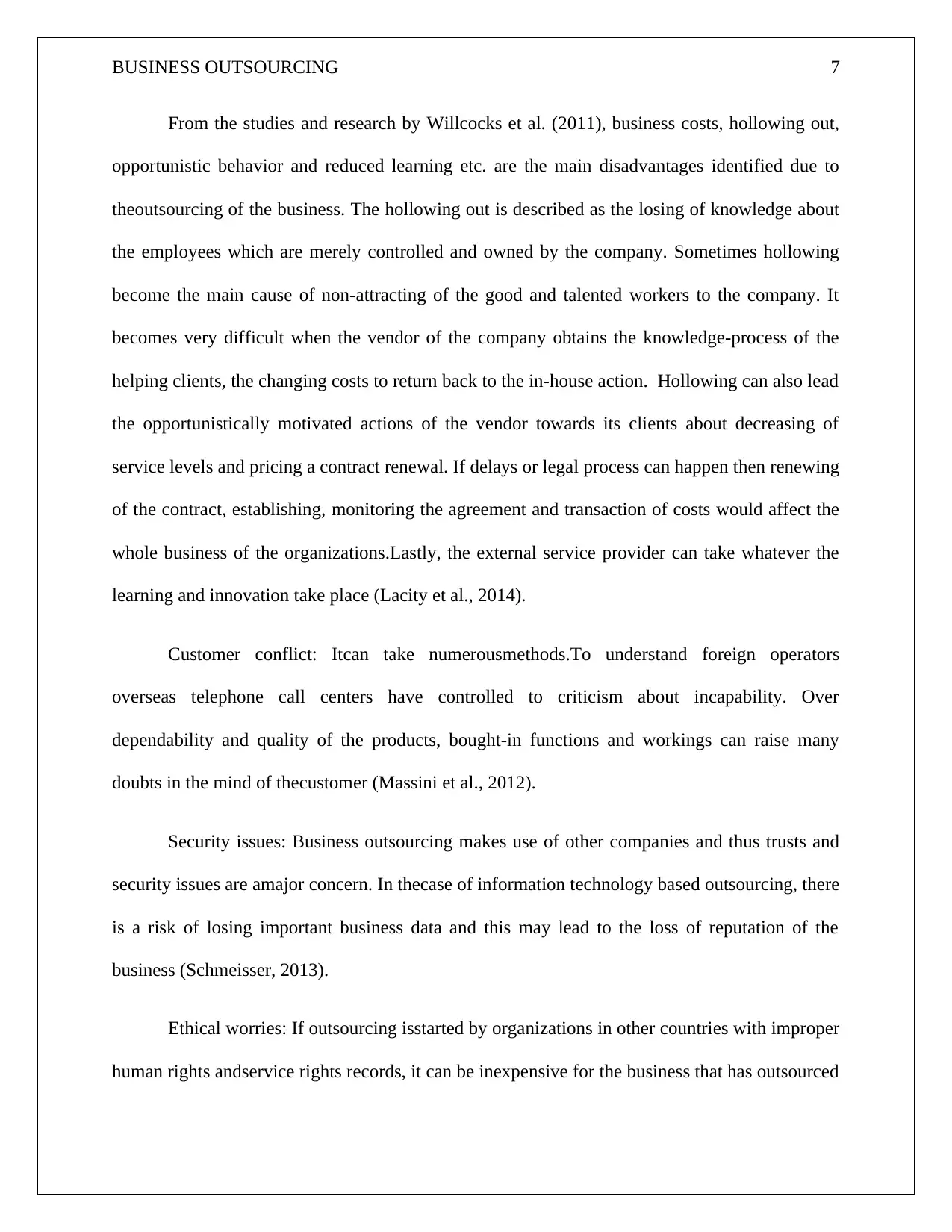
BUSINESS OUTSOURCING 7
From the studies and research by Willcocks et al. (2011), business costs, hollowing out,
opportunistic behavior and reduced learning etc. are the main disadvantages identified due to
theoutsourcing of the business. The hollowing out is described as the losing of knowledge about
the employees which are merely controlled and owned by the company. Sometimes hollowing
become the main cause of non-attracting of the good and talented workers to the company. It
becomes very difficult when the vendor of the company obtains the knowledge-process of the
helping clients, the changing costs to return back to the in-house action. Hollowing can also lead
the opportunistically motivated actions of the vendor towards its clients about decreasing of
service levels and pricing a contract renewal. If delays or legal process can happen then renewing
of the contract, establishing, monitoring the agreement and transaction of costs would affect the
whole business of the organizations.Lastly, the external service provider can take whatever the
learning and innovation take place (Lacity et al., 2014).
Customer conflict: Itcan take numerousmethods.To understand foreign operators
overseas telephone call centers have controlled to criticism about incapability. Over
dependability and quality of the products, bought-in functions and workings can raise many
doubts in the mind of thecustomer (Massini et al., 2012).
Security issues: Business outsourcing makes use of other companies and thus trusts and
security issues are amajor concern. In thecase of information technology based outsourcing, there
is a risk of losing important business data and this may lead to the loss of reputation of the
business (Schmeisser, 2013).
Ethical worries: If outsourcing isstarted by organizations in other countries with improper
human rights andservice rights records, it can be inexpensive for the business that has outsourced
From the studies and research by Willcocks et al. (2011), business costs, hollowing out,
opportunistic behavior and reduced learning etc. are the main disadvantages identified due to
theoutsourcing of the business. The hollowing out is described as the losing of knowledge about
the employees which are merely controlled and owned by the company. Sometimes hollowing
become the main cause of non-attracting of the good and talented workers to the company. It
becomes very difficult when the vendor of the company obtains the knowledge-process of the
helping clients, the changing costs to return back to the in-house action. Hollowing can also lead
the opportunistically motivated actions of the vendor towards its clients about decreasing of
service levels and pricing a contract renewal. If delays or legal process can happen then renewing
of the contract, establishing, monitoring the agreement and transaction of costs would affect the
whole business of the organizations.Lastly, the external service provider can take whatever the
learning and innovation take place (Lacity et al., 2014).
Customer conflict: Itcan take numerousmethods.To understand foreign operators
overseas telephone call centers have controlled to criticism about incapability. Over
dependability and quality of the products, bought-in functions and workings can raise many
doubts in the mind of thecustomer (Massini et al., 2012).
Security issues: Business outsourcing makes use of other companies and thus trusts and
security issues are amajor concern. In thecase of information technology based outsourcing, there
is a risk of losing important business data and this may lead to the loss of reputation of the
business (Schmeisser, 2013).
Ethical worries: If outsourcing isstarted by organizations in other countries with improper
human rights andservice rights records, it can be inexpensive for the business that has outsourced
Paraphrase This Document
Need a fresh take? Get an instant paraphrase of this document with our AI Paraphraser
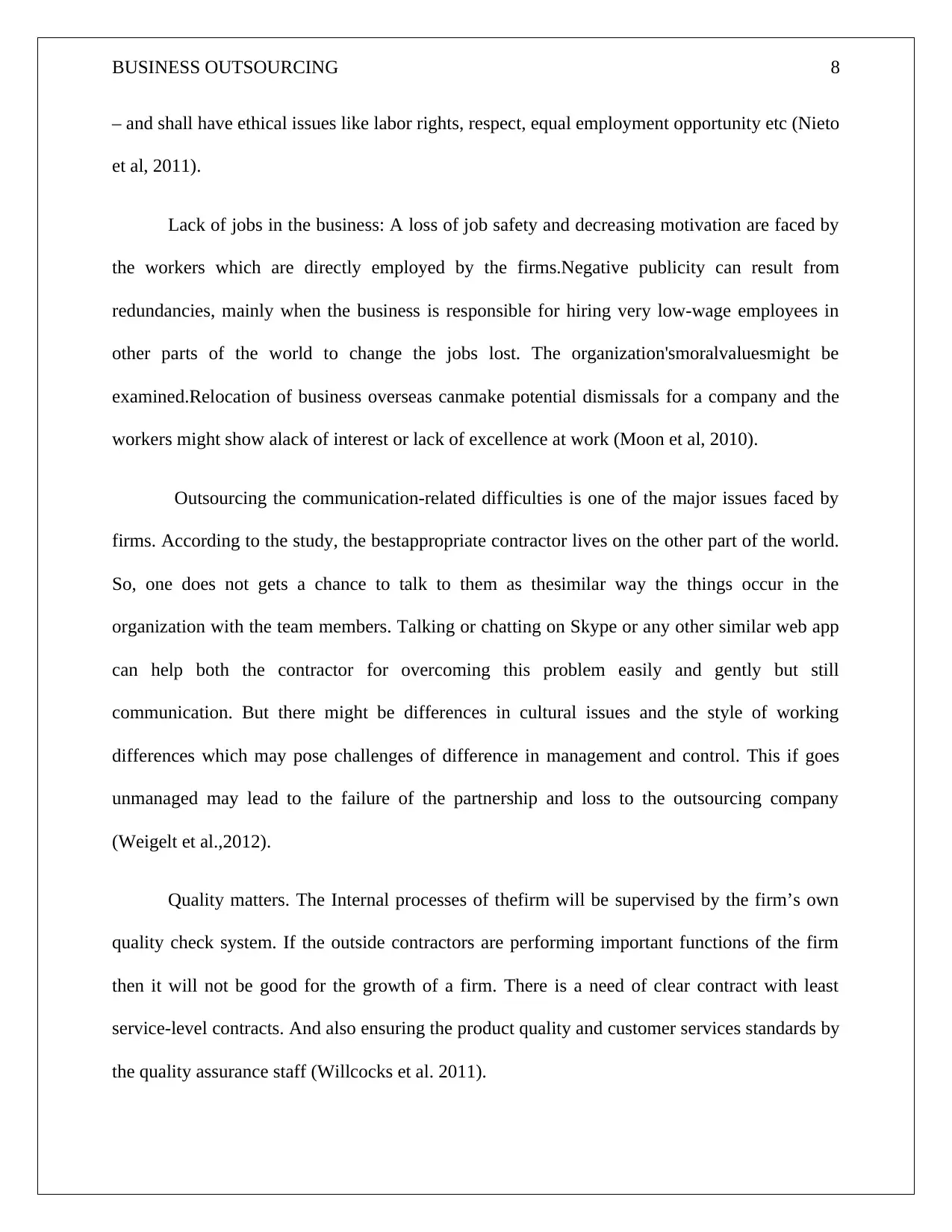
BUSINESS OUTSOURCING 8
– and shall have ethical issues like labor rights, respect, equal employment opportunity etc (Nieto
et al, 2011).
Lack of jobs in the business: A loss of job safety and decreasing motivation are faced by
the workers which are directly employed by the firms.Negative publicity can result from
redundancies, mainly when the business is responsible for hiring very low-wage employees in
other parts of the world to change the jobs lost. The organization'smoralvaluesmight be
examined.Relocation of business overseas canmake potential dismissals for a company and the
workers might show alack of interest or lack of excellence at work (Moon et al, 2010).
Outsourcing the communication-related difficulties is one of the major issues faced by
firms. According to the study, the bestappropriate contractor lives on the other part of the world.
So, one does not gets a chance to talk to them as thesimilar way the things occur in the
organization with the team members. Talking or chatting on Skype or any other similar web app
can help both the contractor for overcoming this problem easily and gently but still
communication. But there might be differences in cultural issues and the style of working
differences which may pose challenges of difference in management and control. This if goes
unmanaged may lead to the failure of the partnership and loss to the outsourcing company
(Weigelt et al.,2012).
Quality matters. The Internal processes of thefirm will be supervised by the firm’s own
quality check system. If the outside contractors are performing important functions of the firm
then it will not be good for the growth of a firm. There is a need of clear contract with least
service-level contracts. And also ensuring the product quality and customer services standards by
the quality assurance staff (Willcocks et al. 2011).
– and shall have ethical issues like labor rights, respect, equal employment opportunity etc (Nieto
et al, 2011).
Lack of jobs in the business: A loss of job safety and decreasing motivation are faced by
the workers which are directly employed by the firms.Negative publicity can result from
redundancies, mainly when the business is responsible for hiring very low-wage employees in
other parts of the world to change the jobs lost. The organization'smoralvaluesmight be
examined.Relocation of business overseas canmake potential dismissals for a company and the
workers might show alack of interest or lack of excellence at work (Moon et al, 2010).
Outsourcing the communication-related difficulties is one of the major issues faced by
firms. According to the study, the bestappropriate contractor lives on the other part of the world.
So, one does not gets a chance to talk to them as thesimilar way the things occur in the
organization with the team members. Talking or chatting on Skype or any other similar web app
can help both the contractor for overcoming this problem easily and gently but still
communication. But there might be differences in cultural issues and the style of working
differences which may pose challenges of difference in management and control. This if goes
unmanaged may lead to the failure of the partnership and loss to the outsourcing company
(Weigelt et al.,2012).
Quality matters. The Internal processes of thefirm will be supervised by the firm’s own
quality check system. If the outside contractors are performing important functions of the firm
then it will not be good for the growth of a firm. There is a need of clear contract with least
service-level contracts. And also ensuring the product quality and customer services standards by
the quality assurance staff (Willcocks et al. 2011).

BUSINESS OUTSOURCING 9
Conclusion
Business outsourcing is said to take place when a company transfers some of its activities
to an outside company and this outsourcing is said to be offshore if these tasks are performed by
the organization residing in some other country. The whole company and its business are
affected by the strategic decision of business process outsourcing. There are many reasons for
which the organization may outsource its business activities. The most common motivation for
business outsourcing is cost reduction. For others, it may be an opportunity to enhance the focus
of the organization on the core business activities. But it can lead to loss of reputation of the
business and pose severe threats to the security and privacy of the data of the company.
References
1. Gantman, S., (2011). IT Outsourcing in the Public Sector: A Literature Analysis. Journal
of Global Information Technology Management. 14, 2 (Apr. 2011), 48--83.
2. Gerbl M., Mclvor,R.,Loane,S.,Humphreys, P. (2015). A multi-theory approach to
understanding the business process outsourcing decision. Journal of World Business.
Volume 50, Issue 3, July 2015, PP. 505-518.
3. Hanafizadeh, P., ZareRavasan, A. (2017). An investigation into the factors influencing
the outsourcing decision of e-banking services: A multi-perspective framework.Journal
of Global Operations and Strategic Sourcing.
4. HEN, J., HONG, H., JIANG, W. and KUBIK, J. D. (2013) Outsourcing Mutual Fund
Management: Firm Boundaries, Incentives, and Performance. The Journal of Finance,
68: 523–558. doi:10.1111/jofi.12006
Conclusion
Business outsourcing is said to take place when a company transfers some of its activities
to an outside company and this outsourcing is said to be offshore if these tasks are performed by
the organization residing in some other country. The whole company and its business are
affected by the strategic decision of business process outsourcing. There are many reasons for
which the organization may outsource its business activities. The most common motivation for
business outsourcing is cost reduction. For others, it may be an opportunity to enhance the focus
of the organization on the core business activities. But it can lead to loss of reputation of the
business and pose severe threats to the security and privacy of the data of the company.
References
1. Gantman, S., (2011). IT Outsourcing in the Public Sector: A Literature Analysis. Journal
of Global Information Technology Management. 14, 2 (Apr. 2011), 48--83.
2. Gerbl M., Mclvor,R.,Loane,S.,Humphreys, P. (2015). A multi-theory approach to
understanding the business process outsourcing decision. Journal of World Business.
Volume 50, Issue 3, July 2015, PP. 505-518.
3. Hanafizadeh, P., ZareRavasan, A. (2017). An investigation into the factors influencing
the outsourcing decision of e-banking services: A multi-perspective framework.Journal
of Global Operations and Strategic Sourcing.
4. HEN, J., HONG, H., JIANG, W. and KUBIK, J. D. (2013) Outsourcing Mutual Fund
Management: Firm Boundaries, Incentives, and Performance. The Journal of Finance,
68: 523–558. doi:10.1111/jofi.12006
⊘ This is a preview!⊘
Do you want full access?
Subscribe today to unlock all pages.

Trusted by 1+ million students worldwide
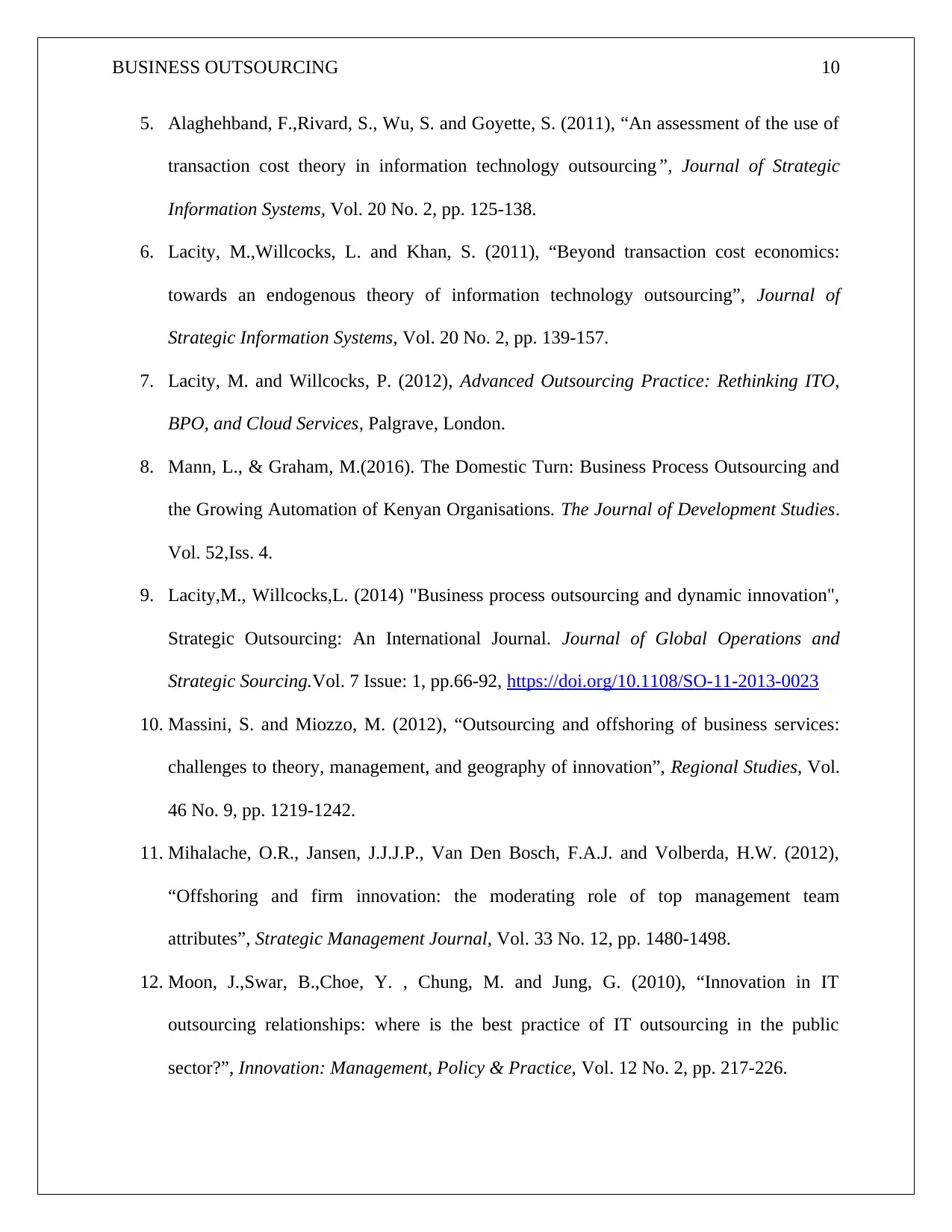
BUSINESS OUTSOURCING 10
5. Alaghehband, F.,Rivard, S., Wu, S. and Goyette, S. (2011), “An assessment of the use of
transaction cost theory in information technology outsourcing”, Journal of Strategic
Information Systems, Vol. 20 No. 2, pp. 125-138.
6. Lacity, M.,Willcocks, L. and Khan, S. (2011), “Beyond transaction cost economics:
towards an endogenous theory of information technology outsourcing”, Journal of
Strategic Information Systems, Vol. 20 No. 2, pp. 139-157.
7. Lacity, M. and Willcocks, P. (2012), Advanced Outsourcing Practice: Rethinking ITO,
BPO, and Cloud Services, Palgrave, London.
8. Mann, L., & Graham, M.(2016). The Domestic Turn: Business Process Outsourcing and
the Growing Automation of Kenyan Organisations. The Journal of Development Studies.
Vol. 52,Iss. 4.
9. Lacity,M., Willcocks,L. (2014) "Business process outsourcing and dynamic innovation",
Strategic Outsourcing: An International Journal. Journal of Global Operations and
Strategic Sourcing.Vol. 7 Issue: 1, pp.66-92, https://doi.org/10.1108/SO-11-2013-0023
10. Massini, S. and Miozzo, M. (2012), “Outsourcing and offshoring of business services:
challenges to theory, management, and geography of innovation”, Regional Studies, Vol.
46 No. 9, pp. 1219-1242.
11. Mihalache, O.R., Jansen, J.J.J.P., Van Den Bosch, F.A.J. and Volberda, H.W. (2012),
“Offshoring and firm innovation: the moderating role of top management team
attributes”, Strategic Management Journal, Vol. 33 No. 12, pp. 1480-1498.
12. Moon, J.,Swar, B.,Choe, Y. , Chung, M. and Jung, G. (2010), “Innovation in IT
outsourcing relationships: where is the best practice of IT outsourcing in the public
sector?”, Innovation: Management, Policy & Practice, Vol. 12 No. 2, pp. 217-226.
5. Alaghehband, F.,Rivard, S., Wu, S. and Goyette, S. (2011), “An assessment of the use of
transaction cost theory in information technology outsourcing”, Journal of Strategic
Information Systems, Vol. 20 No. 2, pp. 125-138.
6. Lacity, M.,Willcocks, L. and Khan, S. (2011), “Beyond transaction cost economics:
towards an endogenous theory of information technology outsourcing”, Journal of
Strategic Information Systems, Vol. 20 No. 2, pp. 139-157.
7. Lacity, M. and Willcocks, P. (2012), Advanced Outsourcing Practice: Rethinking ITO,
BPO, and Cloud Services, Palgrave, London.
8. Mann, L., & Graham, M.(2016). The Domestic Turn: Business Process Outsourcing and
the Growing Automation of Kenyan Organisations. The Journal of Development Studies.
Vol. 52,Iss. 4.
9. Lacity,M., Willcocks,L. (2014) "Business process outsourcing and dynamic innovation",
Strategic Outsourcing: An International Journal. Journal of Global Operations and
Strategic Sourcing.Vol. 7 Issue: 1, pp.66-92, https://doi.org/10.1108/SO-11-2013-0023
10. Massini, S. and Miozzo, M. (2012), “Outsourcing and offshoring of business services:
challenges to theory, management, and geography of innovation”, Regional Studies, Vol.
46 No. 9, pp. 1219-1242.
11. Mihalache, O.R., Jansen, J.J.J.P., Van Den Bosch, F.A.J. and Volberda, H.W. (2012),
“Offshoring and firm innovation: the moderating role of top management team
attributes”, Strategic Management Journal, Vol. 33 No. 12, pp. 1480-1498.
12. Moon, J.,Swar, B.,Choe, Y. , Chung, M. and Jung, G. (2010), “Innovation in IT
outsourcing relationships: where is the best practice of IT outsourcing in the public
sector?”, Innovation: Management, Policy & Practice, Vol. 12 No. 2, pp. 217-226.
Paraphrase This Document
Need a fresh take? Get an instant paraphrase of this document with our AI Paraphraser

BUSINESS OUTSOURCING 11
13. Nieto, M. and Rodríguez, A. (2011), “Offshoring of R&D: looking abroad to improve
innovation performance”, Journal of International Business Studies, Vol. 42, pp. 345-
361.
14. Schmeisser, B. (2013), “A systematic review of literature on offshoring of value chain
activities”, Journal of International Management, Vol. 19 No. 4, pp. 390-406
15. Weigelt, C. and Sarkar, M. (2012), “Performance implications of outsourcing for
technological innovations: managing the efficiency and adaptability trade-off”, Strategic
Management Journal, Vol. 33 No. 2, pp. 189-216.
16. Willcocks, L., Cullen, S. and Craig, A. (2011), The Outsourcing Enterprise, Palgrave,
London.
13. Nieto, M. and Rodríguez, A. (2011), “Offshoring of R&D: looking abroad to improve
innovation performance”, Journal of International Business Studies, Vol. 42, pp. 345-
361.
14. Schmeisser, B. (2013), “A systematic review of literature on offshoring of value chain
activities”, Journal of International Management, Vol. 19 No. 4, pp. 390-406
15. Weigelt, C. and Sarkar, M. (2012), “Performance implications of outsourcing for
technological innovations: managing the efficiency and adaptability trade-off”, Strategic
Management Journal, Vol. 33 No. 2, pp. 189-216.
16. Willcocks, L., Cullen, S. and Craig, A. (2011), The Outsourcing Enterprise, Palgrave,
London.
1 out of 11
Related Documents
Your All-in-One AI-Powered Toolkit for Academic Success.
+13062052269
info@desklib.com
Available 24*7 on WhatsApp / Email
![[object Object]](/_next/static/media/star-bottom.7253800d.svg)
Unlock your academic potential
Copyright © 2020–2025 A2Z Services. All Rights Reserved. Developed and managed by ZUCOL.




